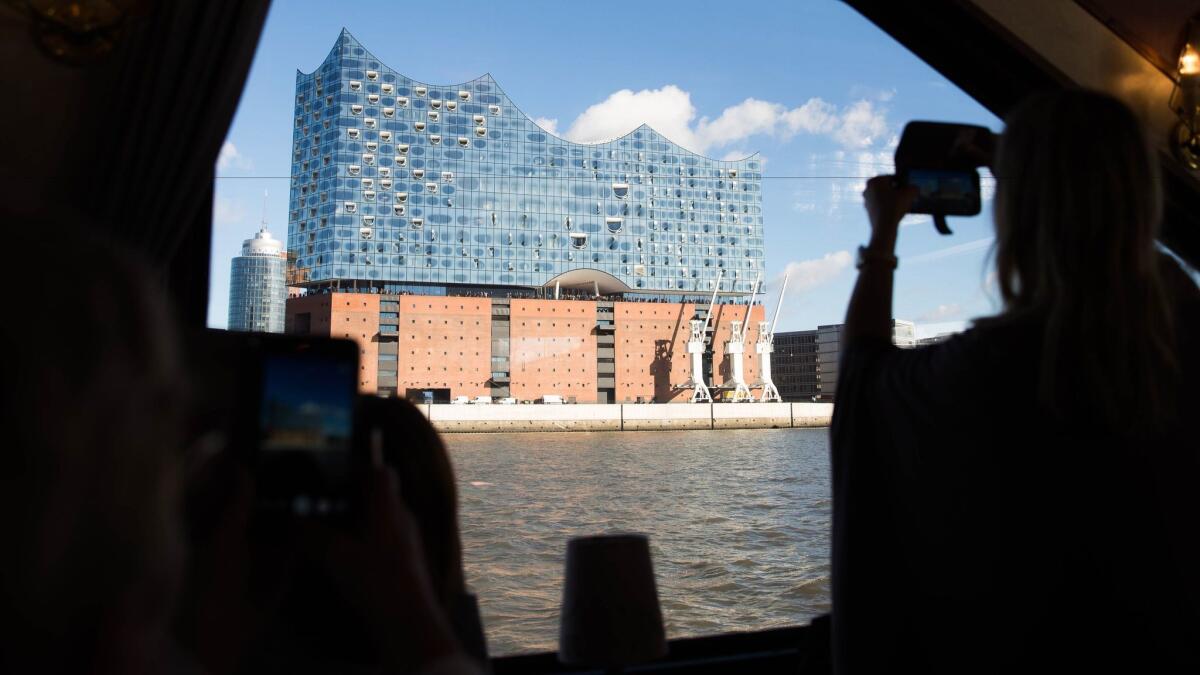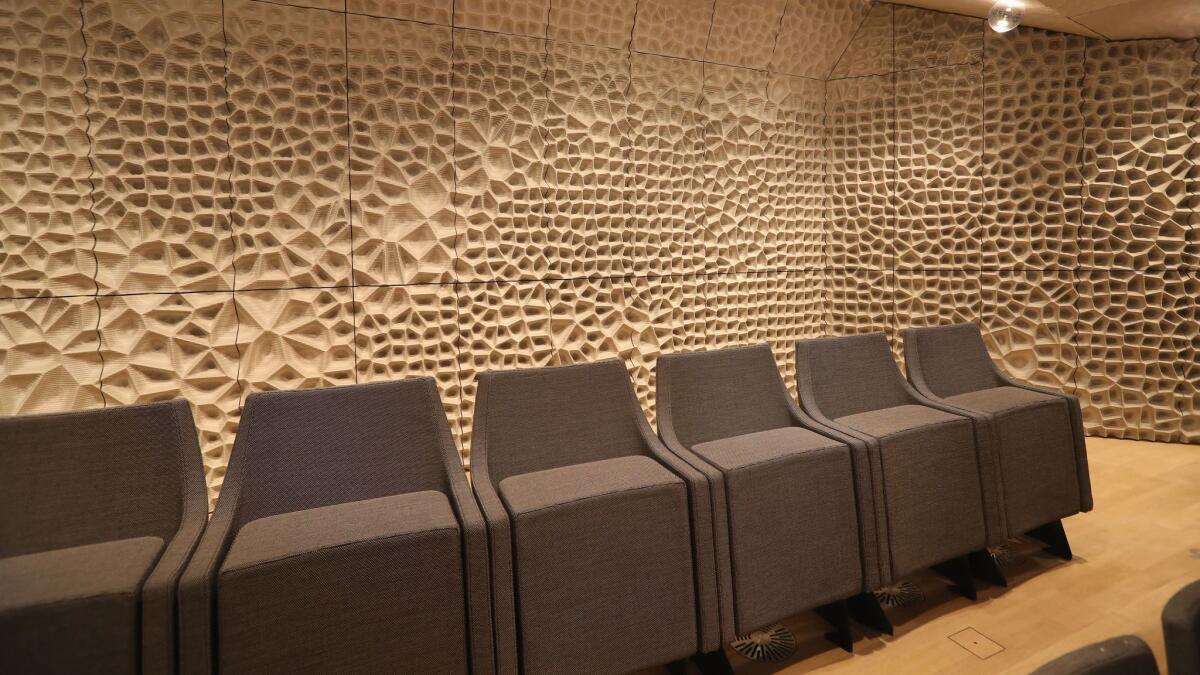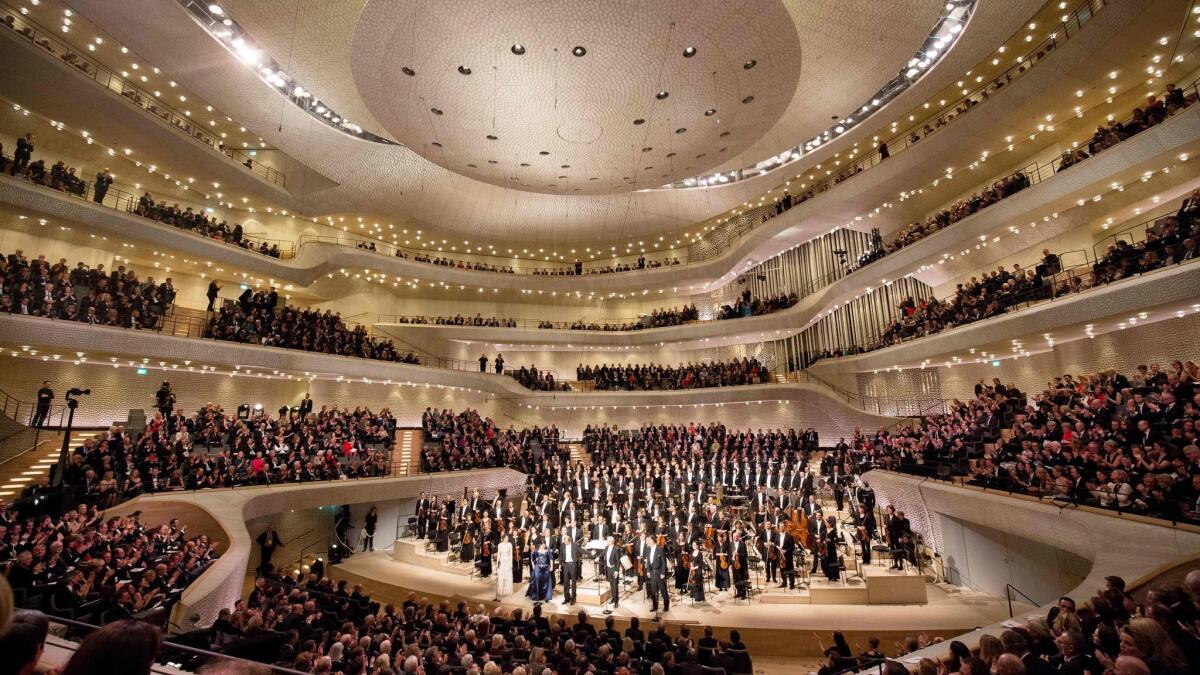How much is a landmark worth? A visit to Herzog & de Meuron’s controversial Hamburg concert hall

- Share via
In 2011, as cost estimates for Hamburg’s new waterfront concert hall soared and kept soaring, Barbara Kisseler, the city’s senator for culture, told reporters that “the Elbphilharmonie is very dear to us. In both senses of the word.”
Skipping past the remarkable fact that Hamburg has a position called “senator for culture,” it is fascinating to consider her statement now that the hall, which cost nearly $1 billion, is open to the public — and now that the public has made it one of the most popular new cultural destinations in northern Europe.
As an example of contemporary design and a civic project, the concert hall, designed by the Swiss firm Herzog & de Meuron, is less a cautionary tale about high budgets or a case study in cultural tourism than a near-perfect distillation of the last two decades of architectural history. Take a dash of Frank Gehry’s Guggenheim Museum in the Spanish city of Bilbao and Richard Meier’s Getty Center, both of which will be celebrating their 20th birthdays this fall. Add pinches of Gehry’s Walt Disney Concert Hall and Diller, Scofidio + Renfro’s Broad Museum in Los Angeles. Throw in bits of Herzog & de Meuron’s own Tate Modern in London and Shigeru Ban’s branch of the Pompidou Center in Metz, France.
Add a generous helping of the backlash to the cult of celebrity architecture that gave rise to all of those buildings. Toss in, as a final ingredient, some slivers of the codependent relationship between Instagram and photogenic architecture. Blend thoroughly and pour into a tall glass that has been chilled for at least 90 minutes in the comments section of an architecture blog.
Voila: architecture circa 2017. It is a recipe that has since January served an audience of more than a million visitors, quite a few of whom couldn’t get a concert ticket and came anyway, to see the remarkable views from the upper levels (or pose for a selfie doing the same). This place is the Broad museum of the classical music world, sold out through the end of the summer.
A high-wire act of a concert hall, the Elbphilharmonie stacks a pair of auditoriums atop an old brick cocoa warehouse on the edge of Hamburg’s port. Its Grand Hall, which seats 2,100, is wrapped in a skin of gypsum panels that appear smooth and white in some photographs but in person are less antiseptic and more richly tactile, bringing to mind the corrugated cardboard that Gehry once used to make furniture.


SIGN UP for the free Essential Arts & Culture newsletter »
The smaller, boxier Recital Hall has movable seats and holds up to 572 people. Herzog & de Meuron designed both auditoriums in collaboration with Yasuhisa Toyota, the acoustician who worked on Disney Hall as well as Gehry’s newly opened Pierre Boulez Hall in Berlin.
To reach either hall visitors step from the wide brick plaza at the foot of the concert hall onto an escalator that takes them to a second, higher plaza inside the building, also lined in brick. The escalator ride, which proceeds through a white tube decorated with inset glass discs, is your first clue that the Elbphilharmonie is not going to be shy about the debt it owes to the greatest hits of architecture’s last two decades: the skyward trip recalls Rem Koolhaas’ Seattle Public Library, the Broad and perhaps most directly of all Jean Nouvel’s Guthrie Theater in Minneapolis, which takes theatergoers from ground level to its aboveground theaters via a very narrow and very slow escalator.
The scene that greets you at the top feels genuinely and generously civic in a way that is not the case at either Disney Hall or the Broad, where public spaces are kept relatively pinched (in order to preserve the drama of entering the auditorium and the column-free top-floor gallery, respectively). Terraces on every side of the building offer views of the port, the Elbe River and the city skyline with a vantage point never before available to the people of Hamburg.
From here you can also see into the Westin Hotel that occupies a section of the building. Much of the remade warehouse below your feet is given over to a multilevel parking structure.
The final bill for the Elbphilharmonie — hotel, car park, escalator, gypsum panels and all — was 866 million euros, or about $935 million, a figure high enough to make even the most dedicated spendthrift blush. More than 90% of the money, according to one recent report, came from public funds.
Was it worth it? My guess is that in a decade or so Hamburg will have decided that it was, just as Sydney would never give up its similarly over-budget opera house and fans of Disney Hall tend to forget how long its construction was delayed in the 1990s. This is not so much because the Elbphilharmonie is an architectural breakthrough, though it does demonstrate that Herzog & de Meuron is at the moment operating at a level above its globe-trotting competitors, but for two other reasons.
The first is that the building, as an already proven tourist draw, is likely to return Hamburg’s investment and then some over time. (As the Broad has proved, a building that turns out to be an Instagram star is these days worth its weight in gold.) Hamburg, the second largest city in Germany, had never before taken full advantage of its rich musical history as the city where Brahms was born and where Handel and Mahler, among several other composers, lived and worked.
Was it worth it? My guess is that in a decade or so Hamburg will have decided that it was.
The second reason is that much of what made the building expensive has also given it an authentic and powerful sense of place. The marriage between old and new grounds the building in its location, in a section of the port called HafenCity, which Hamburg is busy trying to redevelop as a tourism and cultural district.
The base of brick reflects the fact that the material is the lingua franca of the Hamburg port. The glass-wrapped addition, which is dotted on its exterior with puckered openings and looks depending on the light like a circus tent or a ship in full sail, was fabricated by the same company in southern Germany that is helping build the (very, very dear) new Apple campus in Cupertino, Calif.
And if the vast territory given over to parking keeps the lower half of the complex largely disengaged from the sidewalks at its feet, the architects have compensated with the vibrant public plaza in the center of the building and the views it affords.
It would have been easier and probably far cheaper to start from scratch, to build a concert hall here without the warehouse as pedestal. But in that case the (much shorter) result would have been no more and no less than a new concert hall, rather than the strange and compelling mash-up of cultural center, civic square and observation deck that the architects produced.
The result, with its heavy masonry legs and shimmering upper body, is like a centaur, a sphinx or some other mythological hybrid. The building fascinates precisely to the degree that its parts don’t seem, at least at first glance, to fit together.
Twitter: @HawthorneLAT
ALSO
For architects, Trump’s wall reveals as much as it promises to close off
Frank Gehry’s new jewel-box concert hall in the heart of Berlin
Architecture’s highest honor goes to Catalan trio, with a nod to Brexit and Trump
More to Read
The biggest entertainment stories
Get our big stories about Hollywood, film, television, music, arts, culture and more right in your inbox as soon as they publish.
You may occasionally receive promotional content from the Los Angeles Times.











